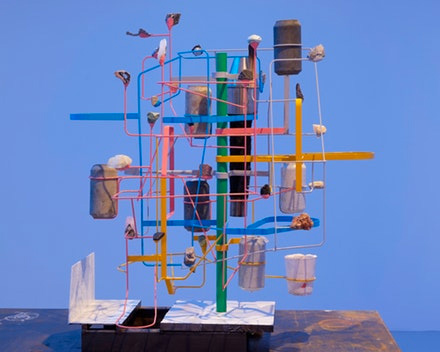
- Source: THE BROOKLYN RAIL
- Author: ROBERT R. SHANE
- Date: OCTOBER 03, 2019
- Format: PRINT AND DIGITAL
Nick van Woert

Nick van Woert, Untitled, 2019. Coal slag, steel, oil paint, white bronze on steel table, 61 x 47 x 29 inches. Courtesy the artist and GRIMM Amsterdam | New York.
In her book Vibrant Matter: A Political Ecology of Things (2010), Jane Bennett argues that inanimate things—emptied of their former human uses as objects—can function as non-human actors, exerting forces of their own in the world analogous to human agency. Her most salient example is a description she borrows from author Robert Sullivan of a decaying trash heap outside Manhattan oozing mercury and other metals and chemicals into a stream, altering its environment. Nick van Woert’s sculptural exhibition Body Parts (2019) resonates with this notion of thing-power. Armatures of stainless steel tubing and wire act like supports for anatomical models, but instead of displaying human organs they hold debris such as motor parts, plastic sheets, ghostly casts of bottles and cups, and formless masses of cement. Taken in sum, these things generate unexpected vitality; in contrast, the casts of human body parts van Woert includes in the exhibition appear devoid of life. The artist has long argued that art is primarily “a material language,” and this exhibition offers us a chance to hear what materials themselves, particularly industrial ones, have to say.
In the first of the exhibition’s two subterranean rooms, overhead fluorescent tubes bathe the space in pink light akin to indoor grow lamps, ironically illuminating five casts of lifeless hands each set atop its own stool. The plaster hands, contaminated by sickly washes of paint in the unnatural hues of soda pop (orange, grape, yellow no. 5), desperately clutch vapes and weed pens, as well as beer cans and bottles cast in cat litter or coal slag. With filthy sleeves dangling from their wrists, these hands look reified. In this room, which is both prelude and foil to a post-Anthropocene vision in the second room, toxic materials, which we ourselves produce and either directly ingest or indirectly absorb through the polluted environment, generate their own vibrant lives indifferent to their effects on ours.
Aglow in cyber-blue light, the second room provides a sterile habitat for three untitled sculptures (all 2019), devoid of any figurative references, stationed upon rectangular, hot-rolled steel tables. In the first piece, brightly painted wire and steel armatures bending at right angles and at times dynamically looping around and within an implied cube of space, hold debris and rocks, such as quartz samples. These things are presented not as passive specimens for observation in a natural history exhibit but rather as nodes within an organized internal network whose exact purpose eludes human comprehension. Like objects consumed then thrown away, the relationships between these things—asphalt clumps, disposable paper cups cast in papier-mâché, cans cast in cat litter, a vertically positioned motorcycle muffler, crystals—are often arbitrary, but from those relationships new inhuman bodies and systems emerge. The crystals in particular call to mind self-organizing, inorganic growth processes (a subject often explored by Robert Smithson). Indeed, another sculpture, a cubic architectural structure partially walled on two sides with plastic sheeting and housing a miniature steel staircase and various suspended motorcycle parts—muffler, hydraulic brake, hoses, rearview mirror—could be the ruins of an abandoned garage self-organizing into a new, post-human ecosystem.

Nick van Woert, Untitled, 2019. Rocks, crystals, stones, concrete, asphalt, palosanto, cat litter, papier-mâché, steel, exhaust pipe, white bronze, oil paint on steel table, 61 x 47 x 29 inches. Courtesy the artist and GRIMM Amsterdam | New York.

